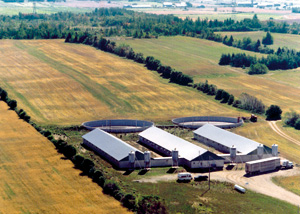2.2 Has Ileitis always been so common?
Because the causative agent has only relatively recently been identified the only possible method for evaluation of incidence of proliferative enteropathy historically was comparison of percentages of frequency of affected pigs at slaughter. Re-examination of events at the time of intensification around 1970, and also with the more recent switch to multiple site farms (see picture 2.2a), suggest that the suspected “increase” in proliferative enteropathy may more accurately reflect an increase in the acute haemorrhagic form, due to a later onset of infection. The past and current percentages of pigs at slaughter with lesions of proliferative enteropathy indicate that in most global settings, a rate of less than 10% has been consistently present. Slaughter tests are more accurate for respiratory and reproductive tract lesions, as these lesions tend to be more long lasting. Lesions of enteric diseases such as proliferative enteropathy, swine dysentery or Escherichia coli are likely to have largely healed by the time the affected pig reaches slaughter weight. Also, misinterpretation of results may occur due to the non-specific nature of mucosal “thickening” within the ileum. Once tests capable of detecting a specific serologic response or antigen became routinely available in the past 5 years, it was evident that proliferative enteropathy is an endemic disease present in post-weaned pigs on most farms, but that many pigs develop a subclinical from or exhibit only mild clinical signs.

Picture 2.2 a (by A. Broes)
A modern high health farm.
© Boehringer Ingelheim Animal Health GmbH, 2006
All rights reserved. No part of this Technical Manual 3.0 may be reproduced or transmitted in any form or by any means, electronic or photocopy, without permission in writing from Boehringer Ingelheim Animal Health GmbH.






